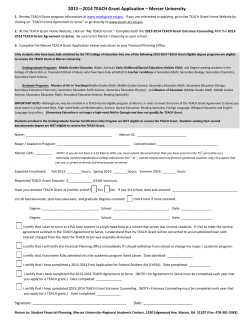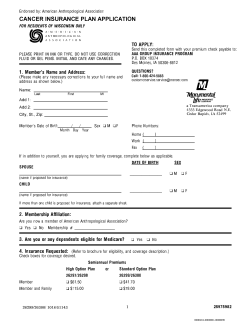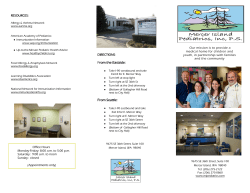
DIVERSITY AND ANALYTICS: HOW TO BUILD AND LEVERAGE DIVERSITY
DIVERSITY AND ANALYTICS: HOW TO BUILD AND LEVERAGE DIVERSITY TO OUTPERFORM THE COMPETITION CONFIDENTIAL This presentation contains proprietary methodologies and tools that remain the property of Mercer. © 2014, Mercer © 2014 MERCER. ALL RIGHTS RESERVED. Today’s Presenters Brian Levine, PhD Partner, Workforce Analytics & Planning Mercer brian.levine@mercer.com Tyronne Stoudemire Principal, Diversity & Inclusion Mercer Alina Polonskaia Principal, Diversity Networks Mercer tyronne.stoudemire@mercer.com alina.polonskaia@mercer.com QUESTIONS To submit a question, use the floating panel on the top of your screen and click the Q&A button: CLICK HERE TO ASK A QUESTION TO “ALL PANELISTS.” © 2014 MERCER. ALL RIGHTS RESERVED. 1 Agenda • Introduction: Four Challenges for D&I • Challenge #1: Moving from Data to Insight • Challenge #2: Understanding Cultural Impediments and Opportunities • Challenge #3: Developing Inclusive Leadership • Challenge #4: Bringing It Together and Sustaining Change • Closing / Q&A © 2014 MERCER. ALL RIGHTS RESERVED. 2 Why Diversity and Inclusion Matters The business case CRITICALITY OF DRIVING PERFORMANCE AND INNOVATION • Diverse workforces and inclusive workplaces linked to innovation. INCREASING LEGISLATION AND REGULATORY PRESSURE • Legislation emerging in EMEA and APAC to bolster diversity. MANAGING RISK, AND REPUTATION • External pressure for transparency from NGOs, government agencies, and watch-dog groups. • Improved culture, greater employee satisfaction and engagement, and increased discretionary effort linked to financial performance. • Increased scrutiny from enforcement agencies in the US. • Greater focus on pay equity and board diversity globally. • Companies lacking D&I awareness face expensive discrimination and harassment lawsuits, lower morale, and recruiting/consumer brand risk. RAPIDLY CHANGING DEMOGRAPHICS • Global nature of workforce demands greater cultural competency. • Aging population globally; several generations in the workplace; greater awareness of and focus on individuals with disabilities. • Increased purchasing power of diverse groups, including women, minorities, and the LGBT community. © 2014 MERCER. ALL RIGHTS RESERVED. 3 CHALLENGE #1: MOVING FROM DATA TO INSIGHT © 2014 MERCER. ALL RIGHTS RESERVED. 4 Mercer’s work with the WEF in 2013 identified significant opportunity Source: The Human Capital Report/WEF 2013 © 2014 MERCER. ALL RIGHTS RESERVED. 5 Look Inside: The Internal Labor Market (ILM) Analysis® Perspective An ILM map represents the flow of people into, through, and out CLIENT EXAMPLE © 2014 MERCER. ALL RIGHTS RESERVED. 6 ILM Maps Can Target Particular Workforce Segments In this case, gender CLIENT EXAMPLE ILM map illustrating the flow of female talent (as a key talent segment) — women face a “glass ceiling” between levels 6 and 7 and leave the company in high numbers at level 6. © 2014 MERCER. ALL RIGHTS RESERVED. 7 Projections Showed that this Organization Would Not Achieve Its Objectives Unless It Improved Hiring, Promotion, and Retention of Women Projections: % Female Senior Managers 2013-2022 40% With adjusted hire, promotion, and termination %s % Female (Senior Managers) 38% 36% Aggressive target 34% With adjusted promotion %s 32% 30% 28% With adjusted term %s With adjusted hire %s 26% Baseline 24% 22% 2012 2013 2014 2015 2016 2017 2018 2019 2020 2021 2022 Year © 2014 MERCER. ALL RIGHTS RESERVED. 8 A Network of Senior Managers, by Gender Case example Male Female Men are more likely to be tightly “clustered” with other men. Women are more likely to be in “connector” positions with links to different parts of the network. Connectors — things we know • Are in a position to be “brokers” of relationships between distant parts of a network. • Can be “gatekeepers” that control the flow of information from one part of a network to another. © 2014 MERCER. ALL RIGHTS RESERVED. Clusters — things we know • Information travels faster within clusters than between (“old boys clubs?”). • Networks grow “unevenly” — new members tend to attach to others already in a cluster. 9 Statistical Modeling Drives Insight Need a disciplined approach to find evidence and drive strategy Three conditions must be met to show that one factor drives another: 1. CORRELATION The factors are related. Span of Control Retention TIME (Directionality) One precedes the other. Span of Control Retention Time 1 Time 2 ISOLATION (Controls) Other factors are ruled.out. Span of Control Retention drives Gender The key is to analyze multiple variables and then isolate those that directly impact the outcome. © 2014 MERCER. ALL RIGHTS RESERVED. LOB Tenure 10 What Actions Will Drive Improved Retention of Women and Minorities? Modeling the drivers of VOLUNTARY turnover CLIENT EXAMPLE Sup's Span (+10 EEs) 48% 39% Levels from Sup (+1) Rating: Needs Improvement 17% Female 15% Promoted (Grade) in Yr 12% Hired in Yr 12% Non-white 9% Tenure in Job (1 more yr) 5% Base Pay ($70K v $60K) -3% -6% Stock Option Value ($60K v $50K) Rating: Excellent -12% -21% Stock Option Receipt -60% -50% -40% -30% -20% -10% 0% 10% 20% 30% 40% 50% 60% Percentage difference in turnover probability © 2014 MERCER. ALL RIGHTS RESERVED. 11 Identifying Areas of Focus and Ensuring Program Alignment Assessing risk at varying levels to understand systemic risk, improve diversity, reinforce desired program norms CLIENT EXAMPLE © 2014 MERCER. ALL RIGHTS RESERVED. 12 Track core metrics, both lagging and leading Diversity dashboards CLIENT EXAMPLE © 2014 MERCER. ALL RIGHTS RESERVED. 13 CHALLENGE #2: UNDERSTANDING CULTURAL IMPEDIMENTS AND OPPORTUNITIES © 2014 MERCER. ALL RIGHTS RESERVED. 14 The Value of Combining Analysis of Your Internal Labor Market with Assessment of Cultural Dynamics Cultural Dynamics • Assess cultural dynamics that pose the most significant risks and opportunities for inclusion • Measure through interviews, focus groups, and employee surveys • Provide further insight on particular practices and managerial strategies What employees and managers SAY Internal Labor Market Dynamics • Assess the opportunity to improve diversity • Identify the root-cause drivers of differences in advancement, in compensation, in retention • Track diversity metrics, both lagging and leading, to assess current state and progress What employees and managers DO By combining what employees and managers SAY with what they DO, we can obtain a holistic understanding of the facts and can effectively prioritize actions © 2014 MERCER. ALL RIGHTS RESERVED. 15 Culture Assessment Qualitative research can shed light on employee experiences and perceptions throughout the life cycle CLIENT EXAMPLE Happiness Across Career/Life Stages Inclusion and retention study: Women at the mid-career point are least satisfied and are more likely to leave. © 2014 MERCER. ALL RIGHTS RESERVED. 16 Culture Assessment Qualitative research can be linked to “hard data analysis” to support robust strategies ABC © 2014 MERCER. ALL RIGHTS RESERVED. 17 CHALLENGE #3: BUILDING INCLUSIVE LEADERSHIP SKILLS © 2014 MERCER. ALL RIGHTS RESERVED. 18 The Power of Inclusive Leadership The Head, Heart, and Guts model Create strategy Manage complexity, ambiguity, and risk Make tough choices Manager of Managers Execute strategy Coach and nurture talent, and align teams Manage conflicts, allocate resources, and take risks First-Line Supervisor Use data to understand root causes Build trust and manage one-onone relationships Give tough feedback and manage performance Build selfawareness . Act with empathy Speak up Executive Individual Contributor © 2014 MERCER. ALL RIGHTS RESERVED. 19 The Power of Inclusive Leadership Cross-cultural competence is one of the most effective tools in inclusive leader’s toolkit Definition: Cross-cultural competence is the ability to discern and take into account one’s own and others’ worldviews; to be able to solve problems, make decisions, and resolve conflicts in ways that optimize cultural differences for better, longer-lasting, and more creative solutions CULTURAL AWARENESS CULTURAL KNOWLEDGE CULTURAL SENSITIVITY CULTURAL COMPETENCY “Me-Centered” Analysis What are my values, beliefs, customs, traditions, styles, biases, stereotypes, and behaviors? (Who am I?) Knowledge Analysis Why are my values, beliefs, customs, traditions, styles, biases, stereotypes, and behaviors the same or different from others? What additional cultural knowledge, awareness, and/understanding do I need? Sensitivity Analysis Am I open to accepting and respecting differences? Why or why not? What are the challenges for me? Can I avoid assigning judgments (be better or worse, right or wrong) to cultural differences? Why or why not? Competency Analysis What adjustments, both in the way I think and behave, do I need to make in order to effectively operate in a different cultural cortex? How do I realize the value that is inherent in diverse perspectives? “Other-Centered” Analysis What are others’ values, beliefs, customs, traditions, styles, biases, stereotypes, and behaviors? © 2014 MERCER. ALL RIGHTS RESERVED. 20 The Power of Inclusive Leadership An example: The Intercultural Development Inventory® (IDI) The gap shows our perceived level of intercultural sensitivity is higher than our actual level. (This is common). The goal is to close that gap by increasing our cultural navigation skills. © 2014 MERCER. ALL RIGHTS RESERVED. 21 CHALLENGE #4: SUSTAINING CHANGE © 2014 MERCER. ALL RIGHTS RESERVED. 22 Sustaining Change Company-specific business case, goals, and metrics are the key to success Increased organizational capacity for innovation and growth Business Case Workforce Attract, develop, and retain highquality, diverse talent D&I goals Work Environment Create an inclusive organizational culture Metrics Marketplace Serve diverse customers and communities Business Strategy Mission and Values © 2014 MERCER. ALL RIGHTS RESERVED. 23 Sustaining Change Embedding D&I in key business and HR processes and practices Talent Acquisition Workforce Planning, Talent Review, and Succession Culture and Engagement Performance Management Change Reward and Recognition Leadership and Employee Development Corporate Social Responsibility/ Sustainability Business Processes © 2014 MERCER. ALL RIGHTS RESERVED. 24 Sustaining Change Learn from experts and peers – the power of Networks Key Attributes Key Roles • Coach • Leader • Change agent © 2014 MERCER. ALL RIGHTS RESERVED. + • • • • • • • • • • Strategic thinking Business proficiency Cultural proficiency Analytical skills Systems thinking People management Political astuteness Process design Program execution Interpersonal insights and influence 25 AN INVITATION © 2014 MERCER. ALL RIGHTS RESERVED. 26 MERCER’S 2014 GLOBAL GENDER RESEARCH — AN INVITATION A differentiating research framework: not just “best practices” Our study will investigate how organizations can accelerate their own representation of women and realize greater value — by linking practices to results. From understanding how women engage in their work and move through their career to considering their unique health and financial management needs, employers must identify and respond to the critical gender issues impacting their business. To that end, Mercer is launching a global research effort to benchmark organizational practices in these areas and assess their impact on the representation and advancement of women in the workforce. ESSENTIAL STRATEGIES FOR TODAY’S GENDER IMPERATIVE: TALENT, HEALTH, AND FINANCIAL WELL-BEING We will release our research findings and collaborate around solutions at Mercer’s inaugural gender conference on November 5-6, 2014, in Washington, DC. © 2014 MERCER. ALL RIGHTS RESERVED. 27 MERCER’S 2014 GLOBAL GENDER RESEARCH — AN INVITATION Benefits of participation Early, no-cost access to the full white paper report, including a custom Internal Labor Market (ILM)® map, which depicts talent flows for your organization and projects future representation, plus reduced-cost access to custom reports Preferential pricing for global workplace gender equality certification through the EDGE Certified Foundation, with whom we are partnering Recognition as a primary participating organization in research reports and at our inaugural gender conference this November 2014 We invite you to participate in this exciting research initiative by June 30, 2014. PLEASE SEND AN EMAIL TO LINDA.CHEN@MERCER.COM © 2014 MERCER. ALL RIGHTS RESERVED. 28 CLOSING / Q&A © 2014 MERCER. ALL RIGHTS RESERVED. 29 What’s Coming Up Next Workforce analytics webcasts, workshops, and data Webcast Series www.mercer.com/mercer-workshops www.mercer.com/webcastseries • Cameco • Experian • John Deere • UMass Memorial Health Care • Johnson Controls • Diversity & Analytics • Value of International Assignments (June 25) Mercer’s Workforce Metrics Benchmark Reports www.imercer.com/wmrs • Workforce composition and retention metrics. • 66 countries. • 6,000+ participants. • Regional and custom editions available. Mercer’s Global D&I Country Factbook www.imercer.com/products/2013/diversity-factbook.aspx © 2014 MERCER. ALL RIGHTS RESERVED. 30 Questions and Answers Brian Levine, PhD Partner, Workforce Analytics & Planning Mercer brian.levine@mercer.com Tyronne Stoudemire Principal, Diversity & Inclusion Mercer Alina Polonskaia Principal, Diversity Networks Mercer tyronne.stoudemire@mercer.com alina.polonskaia@mercer.com QUESTIONS FEEDBACK To submit a question, use the floating panel on the top of your screen and click the Q&A button: Please take a minute to fill out the feedback form so we can continue to improve. It will pop up in a new window when the session ends. Thank you! CLICK HERE TO ASK A QUESTION TO “ALL PANELISTS.” © 2014 MERCER. ALL RIGHTS RESERVED. 31 © 2014 MERCER. ALL RIGHTS RESERVED. 32
© Copyright 2025












